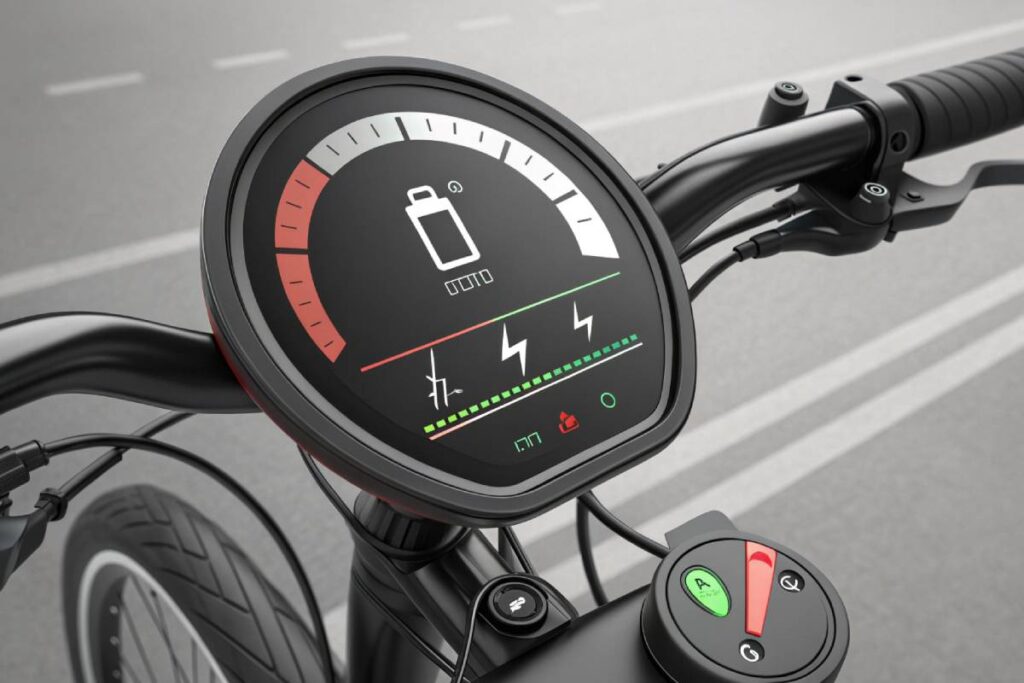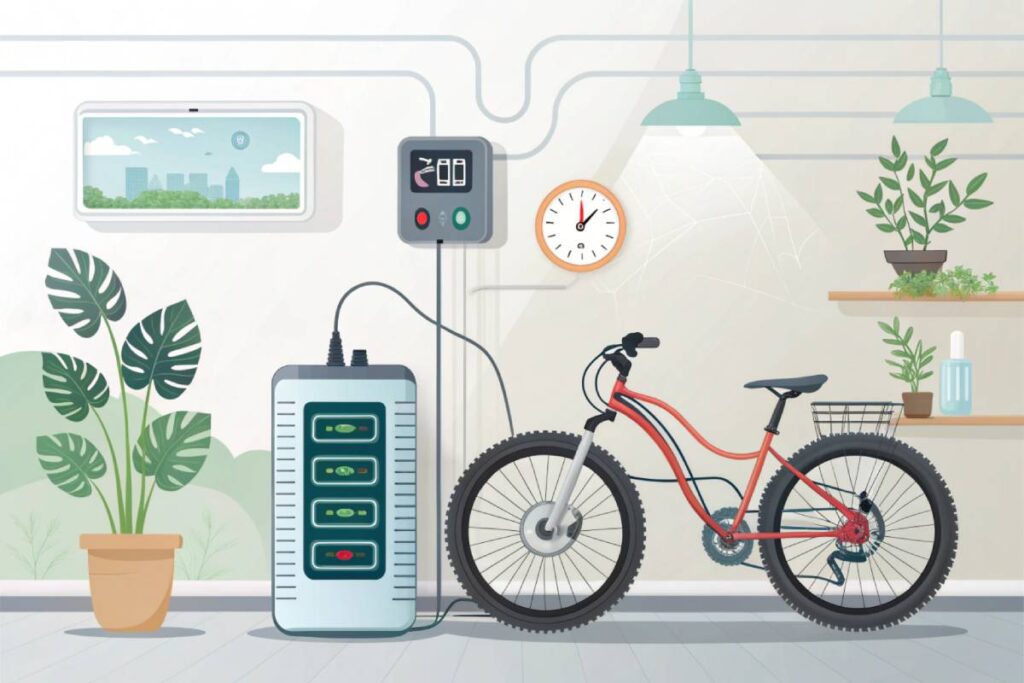Unlock the full potential of your electric bike with expert battery care! Whether you’re a daily commuter or weekend adventurer, maintaining your e-bike’s battery is crucial for longer rides and peak performance.
Imagine cruising effortlessly without worrying about sudden power drops—sounds perfect, right? Dive into our comprehensive guide where we reveal essential tips and tricks to keep your e-bike battery in top shape. From optimal storage solutions to recognizing early signs of degradation, we’ve got you covered.
Get ready to extend your battery’s lifespan and enjoy uninterrupted rides every time you hit the road!

E-bike Battery Care Basics
To get the most miles out of your e-bike’s battery, you gotta treat it right. Knowing how to store it and steering clear of extreme temps can help your battery keep going strong.
Optimal Storage Conditions
Keeping your e-bike battery happy starts with how you store it. The sweet spot for battery storage is between 10 to 20 degrees Celsius, or if Fahrenheit is your thing, that’s 50 to 68. A cool, dry place where the sun’s rays don’t bake it is best to avoid any complications with those lithium-ion cells.
Think about using an insulated bag to stash your battery. It’s like giving it a little jacket against the elements. If you want more know-how, check out our guide on storing your electric bike.
| Storage Condition | Ideal Range |
|---|---|
| Temperature | 10 – 20°C (50 – 68°F) |
Dodging Extreme Temperatures
Leaving your battery in heat or cold ain’t doing it any favors.
- Really Hot: Over 30 degrees Celsius or 86 Fahrenheit, and your battery might start wearing out faster and holding less charge. Charging it when it’s hot is like begging for trouble.
- Really Cold: Below freezing can also put a crimp on performance and chop down its life span. Try charging when it’s icy and you could end up wrecking something.
Make sure your e-bike is stored somewhere with a nice steady temperature. Check out our other article on weatherproofing your e-bike for more ideas.
| Temperature Range | Effect |
|---|---|
| Above 30°C (86°F) | Less juice, more wear |
| Below Freezing | Lousy performance, maybe busted |
Putting thought into how you store your bike and keep tabs on the temperature are basic but important for e-bike health. Stick to these do’s and don’ts and your e-bike battery should keep buzzing along just fine.
Signs of Battery Degradation
Knowing when your battery’s getting tuckered out is essential for all you electric bike fans to keep your rides zippy and fun. Here’s how to tell if your e-bike battery’s starting to feel its age:

Decrease in Range
Notice you’re not cruising quite as far on a single charge these days? It might be your battery losing its mojo. A great way to keep tabs on this is to jot down how many miles you get out of a charge every now and then.
| Charge Cycle | Range (miles) |
|---|---|
| Fresh from the box (1-10 cycles) | 40 – 50 |
| After 6 months (~100 cycles) | 35 – 45 |
| 1 year in (~200 cycles) | 30 – 40 |
| 2 years down the road (~400 cycles) | 20 – 30 |
Wanna dive deeper? Here’s some info on factors affecting your e-bike range.
Reduced Power Output
Feeling like your e-bike’s suddenly got two left feet? If hills give you more grief than usual or your speed just isn’t there, it’s a major hint your battery’s playing catch-up.
Different output vibes:
| Period | Output Perception |
|---|---|
| Brand Spanking New | Zippy, Quick Off the Line |
| After 6 Months | Slightly Tired, Hills Need a Little More Gusto |
| A Year In | Noticeable Slow Down, Hills Are a Real Drag |
| 2 Years | Running on Fumes, Keeps Stalling Out |
Curious about how battery oomph affects different motors? Check out e-bike motor types.
Longer Charging Times
If waiting for your e-bike battery to juice up is feeling like watching paint dry, it might be throwing up a flare. When batteries start to lag, they need extra time to fill up the tank.
Charging time cheat sheet:
| Age of Battery | Charging Times (hours) |
|---|---|
| Brand New | 4-6 |
| 6 Months | 5-7 |
| 1 Year | 6-8 |
| 2 Years | 7-9 |
Want the 411 on charging right? Here’s our guide to charging e-bikes.
Spot these signs early, and you’ll know when it’s time for a little TLC or a new battery altogether. Keep things safe, efficient, and most of all, keep having a blast!
Overheating Prevention
Risks of Excessive Heat
When it comes to electric bike batteries, too much heat is like kryptonite. Like a sizzling car or directly under the blazing sun, being in hot spots can mess with your battery’s mojo. Temperatures shooting over 104 degrees Fahrenheit—that’s over 40 degrees Celsius—can leave your battery saying, “Enough is enough,” leading to a nosedive in performance.
It’s not just about wilting like yesterday’s lettuce—you could end up with a safety hazard on your hands. Overheating can speed up battery aging, and drain its lifespan faster than you can say “expensive replacement,” and in extreme cases, it’s a recipe for a fiery disaster.
Monitoring Battery Temperature
Keeping tabs on your battery’s temperature isn’t just a good idea; it’s your ticket to keeping everything cool and running. Those fancy e-bikes often come with a battery that’s smarter than you think, equipped with sensors to sound the alarm if things heat up. Old school methods like giving it a feel for unusual warmth are still solid moves.
Here’s some hand-me-down wisdom to keep your battery chill:
- Keep it shady: No sunbathing on your bike. Find a cool, shady spot and park it.
- Cool charging spots only: Plug it in somewhere breezy, without turning your place into a sauna.
- Mind those alerts: If your bike’s got the tech, trust it to holler when things get too hot.
Following these nuggets of wisdom keeps your battery happy and healthy, saving you from pricey breakdowns. In case you’re scratching your head about keeping your bike’s battery steady and safe, reach out to the manufacturer or call in the pros.
Stick to these tips, and you’ll keep your e-bike battery running like a champ without breaking a sweat. Check out our other articles on keeping your battery juiced right: charging your e-bike and battery voltage basics.
Avoiding Overcharging
Charging a bike battery too much is like always eating dessert after every meal—not good for your health or your bike’s. Here, we’re gonna chat about how overcharging your battery can be a party pooper for your ride and what weird signals to keep an eye on.
Impact on Battery Life
Those little lithium-ion gremlins inside your bike’s battery are a bit touchy about being fed too much juice. They sulk when overcharged, causing headaches for your trusty ride:
- The Kiss of Death: Keep charging past the full mark, and you might as well give your battery a goodbye hug because it’s not bouncing back.
- Sweat Factory: Overcharging turns things into a sauna—bad news and downright unsafe.
- Fireworks, No Thanks: Some batteries get so mad they catch fire. Yikes!
- Sluggish Buddy: If your bike was a racehorse, overcharging makes it a tired pony. Less range, less speed, not fun.
- Wipe Out Your Wallet: A fried battery means buying a new one. Ouch.
Our friends at Quantum Ebikes remind us to yank the plug when it lights up as “Full” and stash it in a cool, dry hangout.
| What Could Go Wrong | How it Messes Things Up |
|---|---|
| Dead Battery | Shorter Ride Lives |
| Sizzling Hot | Unsafe Stunts |
| Random Fires | Dangerous Shenanigans |
| Slowpoke Mode | Less Zoom, Less Fun |
| New Battery Cash Drain | Extra Expenses |
Overcharging Indicators
Spotting a problem before it’s big helps your e-bike play nice and stay zippy:
- Takes Forever to Charge: If it’s like watching paint dry, you might be overcharging.
- Shorter Ride Adventures: Full battery, but you’re not going far? Something’s off.
- Baby Dragon (Hot Breathe): If it’s hot enough to fry an egg while charging, hold up! That’s too much.
- Wonky Charger: A nutso charger equals too much power and more problems.
| Red Flag | What’s Going Down |
|---|---|
| Charging Marathon | Not its usual quick buck-up |
| Distance Lame | Doesn’t zoom as far |
| Feverish Battery | Hot potato in your hands |
| Charger Acting Up | More power, more issues |
Understanding these quirks will stretch out battery life like a good yoga session. Curious about the right way to power up your ride? Check out our handy guide on how to charge your e-bike and more nifty electric bike maintenance tips.
Getting friendly with these tips means your e-bike battery stays happy and your rides remain an adventure without the drama.
Charging Best Practices
Charging Frequency
Keeping your e-bike battery happy is all about the right habits. Regular checks on charge levels mean your battery stays in tip-top shape for the long haul. Here’s the lowdown on how often to juice up your battery:
| Usage Scenario | Recommended Charging Frequency |
|---|---|
| After every ride | Just like a daily stretch, it keeps performance smooth |
| Daily use | Charge every few days to keep the beats going |
| Light use | When the battery dips below 20%, it’s time for a recharge |
Plugging in after each ride or sticking to a steady charge routine keeps your battery in mint condition for ages. Want more battery tips? Head over to our electric bike maintenance section.

Depth of Discharge
Now, don’t let the fancy term fool you—Depth of Discharge (DoD) is all about not running your battery down to zero. Think of your battery as a marathon runner, not a sprinter. It’s better when it paces itself:
| Depth of Discharge | Impact on Battery Health |
|---|---|
| Shallow discharge (20-30%) | I still relaxed but just kept an eye on it |
| Medium discharge (30-70%) | I still relaxed, but just kept an eye on it |
| Deep discharge (70-100%) | Too much and the battery might feel the burn |
Stay in the safe zone, and your battery will thank you with dependable power each ride. For more battery health secrets, explore our ebike troubleshooting section.
Nailing down the right charge schedule and understanding discharge is like giving your e-bike VIP treatment. Remember these tips, and you’ll enjoy countless rides without a hitch. Want to geek out on batteries? Check out our guides on the best ebike batteries and how to charge ebike.
Maintenance Tips
Keeping your electric bike’s battery in prime condition ain’t just about plugging it in every night. By giving your battery a little love and attention, you’ll not only make it go the distance longer but also keep it revving at top speed. Here’s the lowdown on how to keep it squeaky clean and running smooth.
Cleaning and Inspecting
Just like you wouldn’t let a peanut butter sandwich mess up your phone charger, you gotta keep your bike’s battery contacts spotless. If ignored, even a small dust speck can mess with performance, making it harder for your bike to juice up properly.
How to Clean:
- Power down the e-bike and slide out the battery.
- Grab a dry cloth and wipe those contacts on both the battery and charger like you’re giving them a spa day.
- Look for corrosion or little cracks and scratches that might need attention.
Regular clean-ups can dodge a heap of charging dramas and keep your bike sailing smoothly. Wanna get into more nitty-gritty maintenance? Head over to electric bike maintenance.
Balancing Battery Cells
Think of your battery cells like a team of players—they all need to be on their game to keep the bike winning. Balancing means making sure they’re all charged and drained equally, so no cell is lagging behind or overworked, giving the whole battery a longer life.
Steps to Balance Battery Cells:
- Charge it up: Let the battery fill up till your charger does its happy dance and shows it’s full.
- Ride it out: Take your e-bike for a spin until the battery’s nearly spent—but don’t push it to zero.
- Make it a habit: Do this full recharge and discharge shuffle every couple of months to keep things even.
Balancing doesn’t have to be rocket science with this routine in hand. Plus, more juicy tips on battery smarts await you at ebike battery voltage.
| Maintenance Task | Frequency | Tools Needed |
|---|---|---|
| Cleaning Contacts | Every 2 weeks | Dry cloth |
| Inspecting Battery | Monthly | Your watchful eyes |
| Balancing Cells | Every 3 months | Nada |
Remember these simple chores to keep your battery zipping along with a longer lifespan. We’ve got extras up our sleeves on storing your electric bike and the ins and outs of charging your ebike.
Prolonging Battery Lifespan
Learning the ropes of looking after your e-bike battery can keep it kicking for a long time. So let’s break down the basics: how to stash it properly and juice it up right.
Proper Storage Techniques
How you tuck away your e-bike battery can make a world of difference. Here’s how to do it right:
- Temperature Control: Keep the battery chillin’ in a cool, dry spot, ideally between 50 and 68 degrees Fahrenheit. Steer clear of extreme temps; they’re like kryptonite for battery cells.
- Avoid Full Discharges: Don’t let lithium-ion batteries tap out completely. Instead, keep ’em hanging around 40% to 80% charged if they’re going to be sitting around for a while.
- Ventilation: Air it out! A well-ventilated space helps avoid overheating—pretty important for keeping your battery in top shape.
Correct Charging Habits
Get the hang of solid charging habits, and your e-bike’s battery will thank you in the long run.
- Charging Frequency: Give the battery a top-up after every spin or, at the very least, every few days. This keeps those dreaded deep discharges at bay, which are a real drain on the battery cells.
- Charging Conditions: Put the battery on charge in a cool spot, ideally between 50 and 68 degrees Fahrenheit. Extreme temps—like freezing cold or sweltering heat—are a big no-go.
- Avoid Overcharging: Leaving it plugged in past full charge? Not a good idea. Disconnect once it’s juiced to the max. And yes, keep the charging area cool, dry, and airy to dodge any overcharging.
| Charging Habit | Ideal Practice |
|---|---|
| Charging Frequency | After every ride or every few days |
| Charging Temperature | 50 to 68 degrees Fahrenheit |
| Disconnecting Charger | Once fully charged |
Stick to these tips, and your e-bike battery should stay in fine fettle for many rides to come. For more nuggets of wisdom, check out our guide on electric bike maintenance.
Knowing When to Swap Out
Heads Up Signs
Knowing when it’s time to swap your e-bike battery can keep your ride humming along smoothly. Sometimes, your battery might be trying to tell you something.
Shorter Rides: If you’ve noticed your e-bike’s range is shrinking faster than your snack stash, it might be waving the white flag. A battery struggling to hold its charge means fewer miles on a single boost.
Dropping Power: Feeling like your e-bike’s newfound sluggishness is turning it into a lazy sloth, especially when faced with hills? A battery on its last legs tends to make the ride more meh than yay.
Charge Me Forever: Spending way too much time waiting for that full charge? Well, batteries in their awkward adolescence have a hard time soaking up and holding onto the juice they need.
Heating Up: If your e-bike battery is trying to double as a space heater or taking its sweet time charging, that’s your cue to jump into action. Overcharging can be a sneaky culprit, and addressing these signs sooner means fewer battery woes.
Strange Noises: Odd sounds coming from your battery during charging time isn’t the best tune. It might mean your battery’s on its way out.
For a few pointers on fixing battery hiccups, give our e-bike troubleshooting guide a whirl.
Lifespan Tale
E-bike batteries have different life stories based on factors like their type, how you use them, and how you care for them. Here’s a cheat sheet:
| Battery Type | Lifespan Estimate |
|---|---|
| Lithium-ion (Li-ion) | 2 – 5 years |
| Lead-acid | 1 – 2 years |
| Nickel-metal Hydride (NiMH) | 2 – 3 years |
Lithium-ion (Li-ion): Grabbed a lithium-ion battery? It usually sticks around for about 2 to 5 years. Pamper it with some good care and follow smart charging tips to keep it kicking longer.
Lead-acid: Heavier and not as spry, lead-acid batteries last 1 to 2 years and could use some TLC to deliver at their best.
Nickel-metal Hydride (NiMH): NiMH batteries? Somewhere between lead-acid and lithium-ion in lifespan, around 2 to 3 years.
Keep your battery in tip-top shape with some regular cleaning inspection and cell balancing. For storage pointers, catch our storing guide.
When you know what to watch for and have a handle on life expectancies, your e-bike will remain the trusty sidekick for city hops, weekend beats, or even delivery gigs. Eyeing a new battery? We’ve got you with top e-bike battery tips.
Conclusion
Taking meticulous care of your electric bike’s battery can dramatically enhance your riding experience and ensure that your investment pays off for years to come. By adhering to optimal storage conditions, such as maintaining a temperature range between 50-68°F and keeping your battery away from direct sunlight, you can prevent premature wear and extend its lifespan.
It’s equally important to avoid extreme temperatures, whether scorching heat or freezing cold, as these can significantly diminish battery performance and durability.
Recognizing the early signs of battery degradation—like reduced range, diminished power output, longer charging times, and overheating—enables you to address issues before they escalate.
Implementing best charging practices, such as regular charging without overcharging and understanding the depth of discharge, will keep your battery healthy and efficient. Regular maintenance, including cleaning contacts and balancing battery cells, further ensures that your battery operates smoothly.
Ultimately, being proactive about battery care not only safeguards your e-bike’s performance but also saves you from costly replacements down the line. Stay informed, follow these essential tips, and enjoy countless miles of reliable and exhilarating rides on your electric bike.
Remember, a well-maintained battery is the heart of your e-bike’s longevity and your key to maximizing every adventure.
FAQs
How should I store my e-bike battery during the off-season?
Store your e-bike battery in a cool, dry place between 50-68°F, away from direct sunlight and extreme temperatures. Ideally, keep it partially charged (40-80%) and use an insulated bag for added protection.
What are the signs that my e-bike battery is degrading?
Common signs include a noticeable decrease in range, reduced power output, longer charging times, overheating during use or charging, and inconsistent performance during rides.
Can extreme temperatures permanently damage my e-bike battery?
Yes, exposing your battery to extreme heat or cold can permanently reduce its capacity, shorten its lifespan, and potentially cause safety hazards like overheating or reduced performance.
How often should I charge my e-bike battery?
For daily use, it’s best to charge your battery after every ride. If you use your e-bike less frequently, aim to charge it every few days to maintain optimal battery health.
Is it bad to leave my e-bike battery charging overnight?
Yes, consistently overcharging your battery by leaving it plugged in after it’s fully charged can degrade its lifespan. It’s recommended to disconnect the charger once the battery reaches full charge.
Final Thoughts
Maintaining your electric bike’s battery is more than just a routine task—it’s a commitment to ensuring your rides are always smooth, efficient, and enjoyable. By following the best practices outlined in this guide, you not only extend the life of your battery but also enhance the overall performance of your e-bike.
Remember, a well-cared-for battery means fewer interruptions, less downtime, and more freedom to explore the roads you love. Stay proactive with regular maintenance, stay informed about the signs of battery wear, and don’t hesitate to seek professional advice when needed.
Your e-bike is a valuable companion, and with the right care, it will continue to serve you reliably for years to come. Embrace these tips, take pride in your maintenance routine, and enjoy every electrifying mile!
Key Tips Around E-Bike Battery Care
- Store Properly: Keep your battery in a cool, dry place within the recommended temperature range.
- Avoid Extreme Temperatures: Protect your battery from excessive heat and freezing cold to prevent damage.
- Regular Charging: Charge your battery after each ride or every few days to maintain optimal charge levels.
- Prevent Overcharging: Disconnect the charger once the battery is fully charged to avoid degradation.
- Clean Contacts: Regularly wipe the battery and charger contacts to ensure efficient power transfer.
- Balance Battery Cells: Periodically balance the cells by fully charging and partially discharging the battery.
- Monitor Performance: Keep an eye on the range, power output, and charging times to detect early signs of wear.
- Use Insulated Storage: Consider using an insulated bag to protect your battery from environmental factors.
- Follow Manufacturer Guidelines: Always adhere to the specific care instructions provided by your battery’s manufacturer.
- Seek Professional Help: If you notice unusual behavior or performance issues, consult a professional technician.
Recommended Biking Products and Accessories
- E-Bike Battery Insulated Bag
- Protect your battery from temperature fluctuations with this high-quality insulated storage bag.
- Smart Charger for E-Bikes
- Ensure optimal charging cycles and prevent overcharging with a smart, automated charger.
- Temperature Monitoring Sensor
- Keep an eye on your battery’s temperature in real-time to prevent overheating.
- Battery Cleaning Kit
- Maintain spotless battery contacts with a specialized cleaning kit, including brushes and cloths.
- Portable Battery Stand
- Securely hold your battery while charging in any environment with this portable stand.
- Weatherproof Battery Cover
- Shield your battery from the elements with a durable, weather-resistant cover.
- E-Bike Maintenance Toolkit
- Equip yourself with essential tools for regular battery and bike maintenance tasks.
- Battery Cell Balancer
- Extend your battery’s lifespan by ensuring all cells are evenly charged with this balancer.
- High-Capacity Power Bank
- Have an extra power source on hand for long rides with this high-capacity power bank.
- UV-Proof Battery Case
- Protect your battery from harmful UV rays with a specialized UV-proof case.
By implementing these strategies and utilizing the recommended resources and products, you can ensure your electric bike’s battery remains in excellent condition, providing you with reliable and enjoyable rides for years to come.




